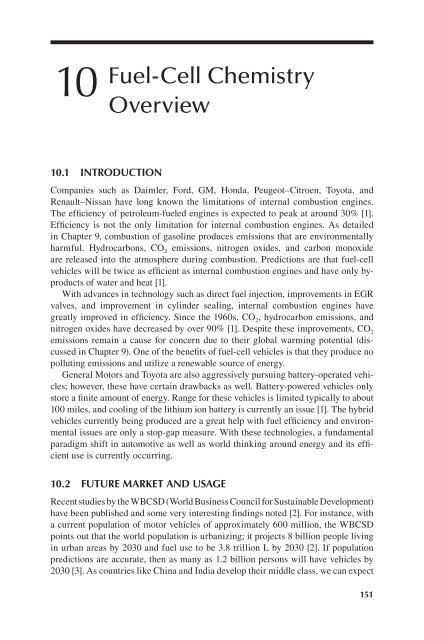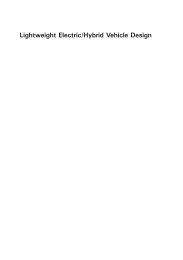THE ROLE OF THE
THE ROLE OF THE
THE ROLE OF THE
Create successful ePaper yourself
Turn your PDF publications into a flip-book with our unique Google optimized e-Paper software.
10<br />
Fuel-Cell Chemistry<br />
Overview<br />
10.1 IntroductIon<br />
Companies such as Daimler, Ford, GM, Honda, Peugeot–Citroen, Toyota, and<br />
Renault–Nissan have long known the limitations of internal combustion engines.<br />
The efficiency of petroleum-fueled engines is expected to peak at around 30% [1].<br />
Efficiency is not the only limitation for internal combustion engines. As detailed<br />
in Chapter 9, combustion of gasoline produces emissions that are environmentally<br />
harmful. Hydrocarbons, CO 2 emissions, nitrogen oxides, and carbon monoxide<br />
are released into the atmosphere during combustion. Predictions are that fuel-cell<br />
vehicles will be twice as efficient as internal combustion engines and have only byproducts<br />
of water and heat [1].<br />
With advances in technology such as direct fuel injection, improvements in EGR<br />
valves, and improvement in cylinder sealing, internal combustion engines have<br />
greatly improved in efficiency. Since the 1960s, CO 2, hydrocarbon emissions, and<br />
nitrogen oxides have decreased by over 90% [1]. Despite these improvements, CO 2<br />
emissions remain a cause for concern due to their global warming potential (discussed<br />
in Chapter 9). One of the benefits of fuel-cell vehicles is that they produce no<br />
polluting emissions and utilize a renewable source of energy.<br />
General Motors and Toyota are also aggressively pursuing battery-operated vehicles;<br />
however, these have certain drawbacks as well. Battery-powered vehicles only<br />
store a finite amount of energy. Range for these vehicles is limited typically to about<br />
100 miles, and cooling of the lithium ion battery is currently an issue [1]. The hybrid<br />
vehicles currently being produced are a great help with fuel efficiency and environmental<br />
issues are only a stop-gap measure. With these technologies, a fundamental<br />
paradigm shift in automotive as well as world thinking around energy and its efficient<br />
use is currently occurring.<br />
10.2 Future marKet and usage<br />
Recent studies by the WBCSD (World Business Council for Sustainable Development)<br />
have been published and some very interesting findings noted [2]. For instance, with<br />
a current population of motor vehicles of approximately 600 million, the WBCSD<br />
points out that the world population is urbanizing; it projects 8 billion people living<br />
in urban areas by 2030 and fuel use to be 3.8 trillion L by 2030 [2]. If population<br />
predictions are accurate, then as many as 1.2 billion persons will have vehicles by<br />
2030 [3]. As countries like China and India develop their middle class, we can expect<br />
151







